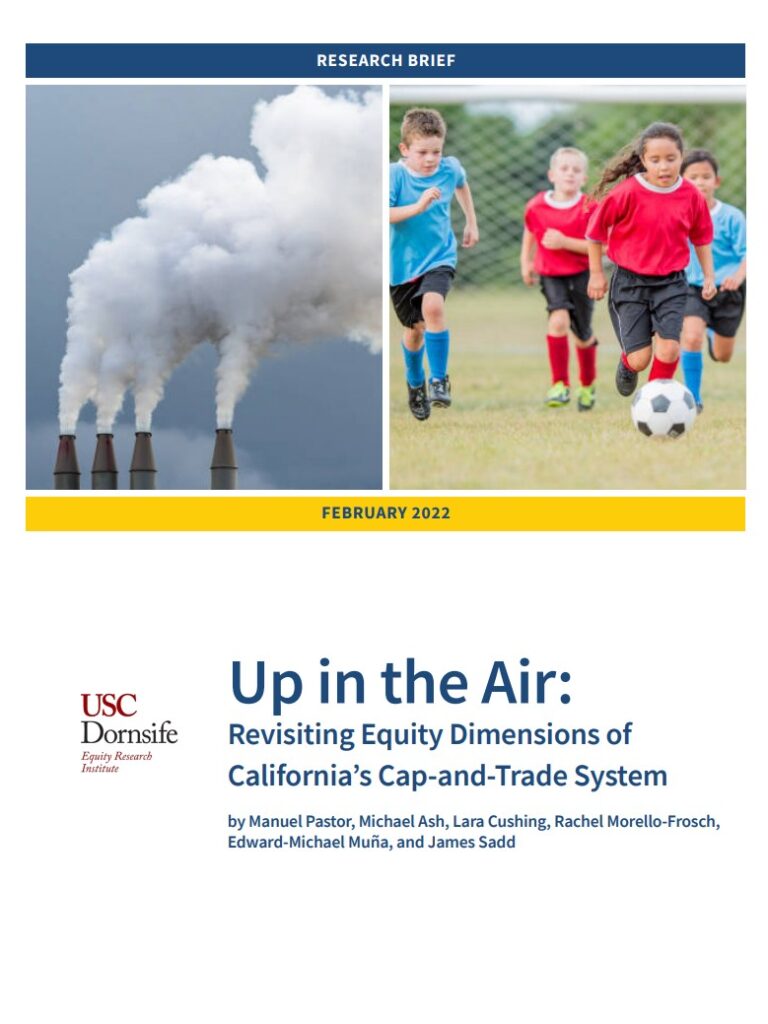
Up in the Air: Revisiting Equity Dimensions of California’s Cap-and-Trade System
February 1, 2022
By Manuel Pastor, Michael Ash, Lara Cushing, Rachel Morello-Frosch, Edward-Michael Muña, and James Sadd
California’s cap-and-trade program is a key strategy for achieving reductions in greenhouse gas (GHG) emissions under AB32, the California Global Warming Solutions Act. While there are many equity considerations with regard to cap-and-trade, including the ways in which funds collected and disbursed, one point of controversy between proponents and critics of cap-and trade systems is whether they can ameliorate or exacerbate disparities in exposure to co-pollutants.
This report examines whether such disparities have persisted over the second compliance period (2016-2017) compared to the period immediately prior to the beginning of the cap-and-trade program (2011-2012). We look at the issue from both the facility and neighborhood perspective, comparing the changes in period averages for covered GHGs, PM2.5, PM10, NOX, and SOX. Breaking either the facilities or the neighborhoods into thirds by the change in pollutants, we find that the facilities and neighborhoods that were “least improved” (which in all cases actually worsened in terms of GHG and co-pollutant levels) tended to have higher shares of people of color, people living below 200 percent of the poverty level, households that were linguistically isolated, and individuals who were less educated, as well as higher CES scores. We also compare the change in pollutants in certain neighborhoods California designates as “Disadvantaged Communities” (or DACs) that hosted facilities with non-DAC areas that hosted facilities. In nearly all cases, the DACs saw some improvements in terms of reduced pollutants from cap-and-trade facilities but these improvements were less than in the non-DACs, with many of the contrasts being statistically significant.
We close by noting that the issue of co-pollutants is only one of many equity considerations that arises from efforts to reduce GHGs. Nonetheless, it has raised concerns and we suggest ways to modify market mechanisms to better acknowledge and address distributional issues. We also call for additional research, including data assembly and modeling, and suggest that a robust discussion of the California experience can help other states and the nation as others also seek to integrate sustainability and environmental justice goals in climate change policy.
Our study of the environmental justice dimensions of California’s cap-and-trade program is one of a series of recent efforts to look at this issue. In our report, we discuss extensively one academic study by Danae Hernandez-Cortes and Kyle Meng and suggest various challenges with their methodology and data treatment. In the spirit of collegial exchange, we post their response to our discussion here.
Another research effort – which looked at cap-and-trade but also other aspects of California’s policies to address greenhouse gases – was conducted by colleagues at the California Office of Environmental Health Hazard Assessment (OEHHA) and is available here. We are thankful to that research team for consultation about methods and data and benefited greatly from our pre-publication exchanges.
The part of their study looking at cap-and-trade has some similarities and some differences to our findings. We both find that emitters are disproportionately located in low-income communities of color. Partly because OEHHA focuses on aggregate impacts, they find the biggest benefits in co-pollutant reduction in those communities; our approach looks at average (or median) impacts and expresses more concerns re: equity.
The studies also differ in the way they measure proximity, the years studied, and numerous other aspects of analysis, all of which impact the findings. Reading both studies offers a fuller picture of the role of methodological choices and the potential effects of cap-and-trade. What they share is a commitment to the principles of environmental justice, the importance of solid scientific research, and the belief that we need better and more current data to track how well the state is doing on meeting its twin promises to address climate change and promote environmental equity.



